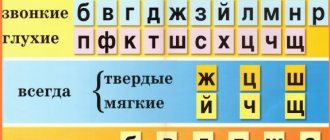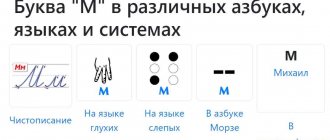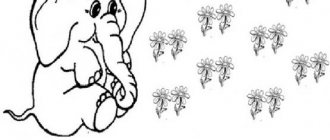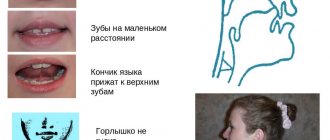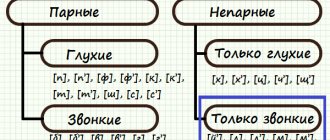Automation of sound [З] in the middle of words:
FOR : va-za, ba-za, ko-za, back, fa-zan, ka-zak, smear, e-go-za, me-du-za, mi-mo-za, u- to-show, to-show, to-show, mo-za-i-ka, don’t-for-wake-ki, at-ka-za-n-e. AZ : name, az-bu-ka, name-va-ni-e; ZO : bi-zone, vozok; OZ : air-spirit; ZU : ve-zu, ma-zut, down-zu; PS : vo-zy, ta-zy, ko-zy, va-zy, ya-zyk, mu-zy-ka, mu-zy-kant, call; FROM : from-ba, from-gib, from-mump, from-tok, from-nan-ka, from-yes-no-e.
Automation in spontaneous speech
Consolidating the sound “Z” in spontaneous speech includes adult control over the child’s pronunciation.
It is important to monitor correctness and immediately correct defects so that the child does not develop stereotypes.
You can return to each stage of sound production if necessary, and play games for reinforcement and automation.
Adult speech is the main tool for fixing sounds in a child’s phonemic structure. By surrounding children with literate speech, adults create an atmosphere for the correct development of their sound pronunciation.
Automation of sound [З] at the beginning of words:
FOR : for something, for-west, for-deep, for-water, for-law, for-cat, for-smell, for-drive, for-run, for-sing, for-howl, for-be, come in, come in, drive in, for-bo-ta, for-ba-va, for-te-ya, for-vi-tok, for-ku-tok, for-guess-give, for- think, kick, kick, want, kick, kick, sing, pull, kick, kick to go, to run, to give, for yin-ka, for-pon-ka, for-bad-ka, for-vet-ny, for-da-ni-e, for-da- wa-ka, for-bi-ya-ka, for-go-to-vit, for-go-to-to-ka; ZO : Zo-ya, umbrella, umbrella-tic; ZU : tooth, tooth, tooth-side, tooth-noy, tooth-bat-ka; PS : unsteady.
Articulation of sound Z
The lips are not tense, stretched, as with a slight smile, then take the position of the following vowel.
The teeth are brought closer together by 1-1.5 mm, the upper and lower incisors are exposed.
Tongue – the tip of the tongue is wide, located behind the lower teeth, at the lower alveoli; the front and middle part of the back of the tongue rises slightly higher to the upper gums than when pronouncing the sound C, but the tension of the tongue is somewhat weaker and in the form of a longitudinal groove between the back of the tongue and the alveoli is narrower than with voiceless C and C'; the back of the back of the tongue is raised, the lateral edges of the tongue fit tightly to the inside of the upper and partly lower lateral teeth, closing the passage of the air stream on the sides.
The soft palate is raised, blocking the passage of the air stream into the nasal cavity.
The vocal cords are closed and vibrate.
The air stream is narrow, cold, but weaker and less tense than when pronouncing the sound C.
Differentiation from consonant sounds
Preschoolers have problems distinguishing paired sounds. They often change “Z” to “S”. To solve this problem, the teacher offers differentiation games.
Work on differentiation of sounds is carried out in the following directions:
- development of auditory differentiation;
- consolidation of pronunciation differentiation;
- formation of phonemic analysis and synthesis.
First, the speech therapist asks you to feel the difference in pronunciation using your hand, which is located on your neck.
It is important for children to remember that with “Z” the throat vibrates.
Then children place an open palm in front of their mouth and feel the difference in the air stream that comes out when pronouncing similar sounds.
At the next stage, work is carried out with speech material with mixed sounds. Exercises are carried out to divide words into groups with different letters, gymnastic games with clapping and other movements.
Games and exercises to automate the sound [З] in syllables:
- Exercise “Repeat syllable chains”:
Ask the child to say ZA-ZA-ZA and at the same time walk with his fingers along the
while completing tasks. When the child learns to speak these syllables, you can move on to others or alternate them.
FOR - ZO - ZU ; FOR - ZU - ZO FOR - ZO - FOR - ZU; FOR - ZU - ZY
2. Automation of sound [З] in straight syllables:
FOR – FOR – FOR – FOR – FOR ZY – ZY – ZY – ZY – ZO ZO – ZO – ZO – ZO – ZO ZU – ZU – ZU – ZU – ZU
3. Automation of the sound [З] in reverse syllables:
AZZ – OZZ – UZZ – IZZ EZZ – YZZ – YZZ – YAZZ
4. Sound [З] in intervocalic syllables:
AZA – AZO – AZU – AZY UZA – UZO – UZU – UZY OZA – OZO – OZU – OZY YZA – YZO – YZU – YZY
5. Automation of the sound [З] in syllables with a combination of consonants:
ZNA - ZNO - ZNU - ZNY ZMA - ZMO - ZMU - ZMA ZVA - ZVO - ZVU - CALLS ZDA - ZDO - ZDU - ZDA
Helpful Tips:
- At the beginning of each sound automation lesson [Z], we conduct 2-3 articulatory gymnastics exercises.
- During the lesson, pay attention to the correct articulation of the sound [Z] (see articulatory gymnastics).
- We pronounce the words slowly, clearly emphasizing the sound [З]. Repeat words 2-3 times.
- Classes are held regularly for 20-25 minutes depending on the age of the child and alternating play exercises.
- At the first signs of fatigue, take a physical minute. Kinesiological exercises are very useful for relieving tension and emotional relaxation.
- Classes should be conducted in a friendly and comfortable environment for the child.
For greater efficiency, the sound [З] in words is automated sequentially: first we conduct classes on automating the sound at the beginning of words, then in the middle, at the consonant cluster.
On our website you can download pictures in A4 format, cut them into cards, preferably laminate them for long-term use and have fun with them.
Preparatory exercises
Speech therapy correction work begins with the preparatory stage, which includes:
- preparing children for classes;
- exercises to train the articulatory apparatus;
- study of speech organs;
- familiarization with self-massage techniques;
- exercises to develop the muscles of the neck and shoulders;
- development of fine motor skills.
The lesson begins by inviting the child to play; you can tell him fairy tales about the Tongue. If you get your child interested, he will perform the exercises more actively, which means he will achieve a positive result faster.
Preparatory complex:
Children are more willing to do exercises with edible straws.
- Self-massage. The fingertips stroke the facial muscles in the direction of:
- from the middle of the forehead to the temples;
- around eyes;
- from the bridge of the nose to the ears;
- along the back of the nose up and back.
- Vibration massage. Tapping the wings of the nose while pronouncing the sound “M”.
- Studying parts of the speech apparatus in front of a mirror. Together with the child, name the speech organs and consider their location.
- Games for stretching and relaxing the muscles of the shoulder girdle: “Stretch”, “Cat”.
- Lacing games according to the Montessori system for training fingers and developing fine motor skills.
Types of incorrect articulation
Violations in the pronunciation of “Z” can be divided into 2 groups:
- expressed in distorted pronunciation of whistling sounds (sigmatism);
- expressed in replacement with other sounds (parasigmatisms).
Types of sigmatism:
- Interdental. The tip of the tongue is located between the teeth. Speech acquires a “lisp.”
- Side. The lateral edge of the tongue is pressed to the right or left to the molars. The tongue rolls to one side.
- Nasal. When speaking, air enters the nasal cavity. Nasal sigmatism occurs in children with cleft palate or palate paralysis.
Types of parasigmatism:
- Prizubny. When pronouncing the sound “Z”, the tongue rests on the closed teeth. Because of this, “Z” is replaced by “D”.
- Hissing. During pronunciation, the lips are strongly rounded and no groove is formed on the tongue. "Z" changes to a soft "F".
- Emollient. The mouth does not open enough, the teeth do not come apart from each other. The result is a sound that is softer than required.
- Replacements due to deafness. The lips are drawn out into a long tube, the tongue does not rest on the teeth, and there is no sonorous sound.
If defects in sound pronunciation are not corrected, then during school years the child will develop illiterate oral and written speech and will have problems with reading and understanding what is read.
In addition, problems with sound pronunciation can arise as a result of damage to the speech parts of the brain.
If a child has a correctly formed articulatory apparatus, but the sound is still not produced, it is worth seeking advice from a neuropsychologist. He will conduct a diagnosis and draw up a correction plan.



